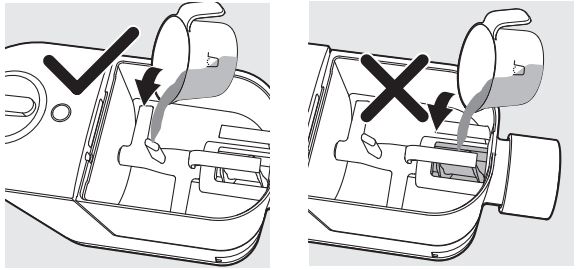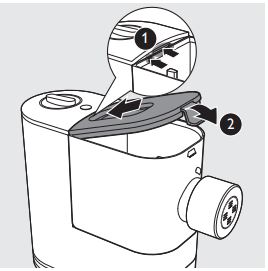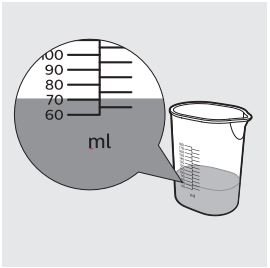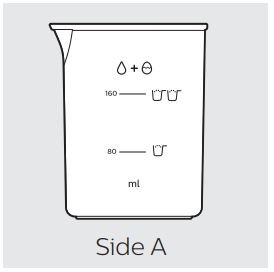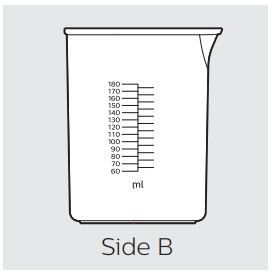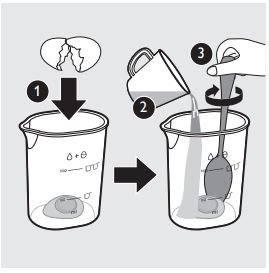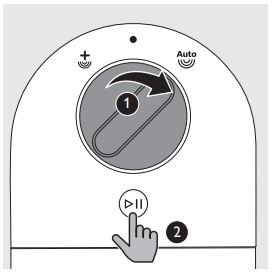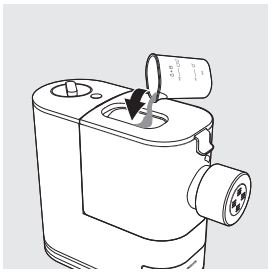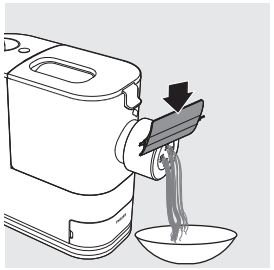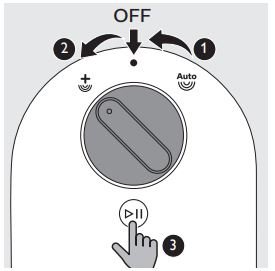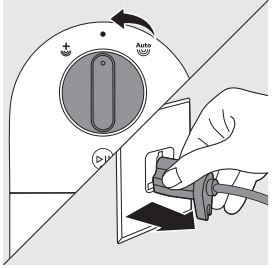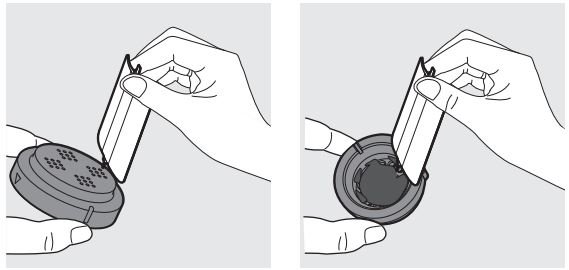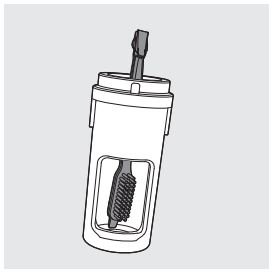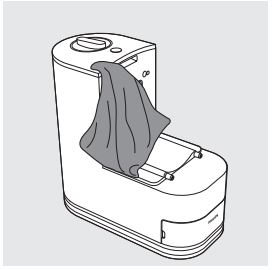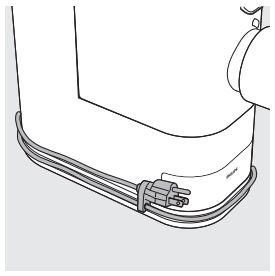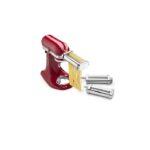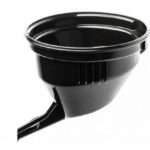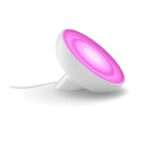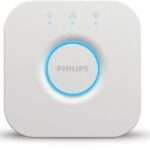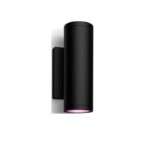Philips HR2370 Compact Pasta and Noodle Maker User Manual

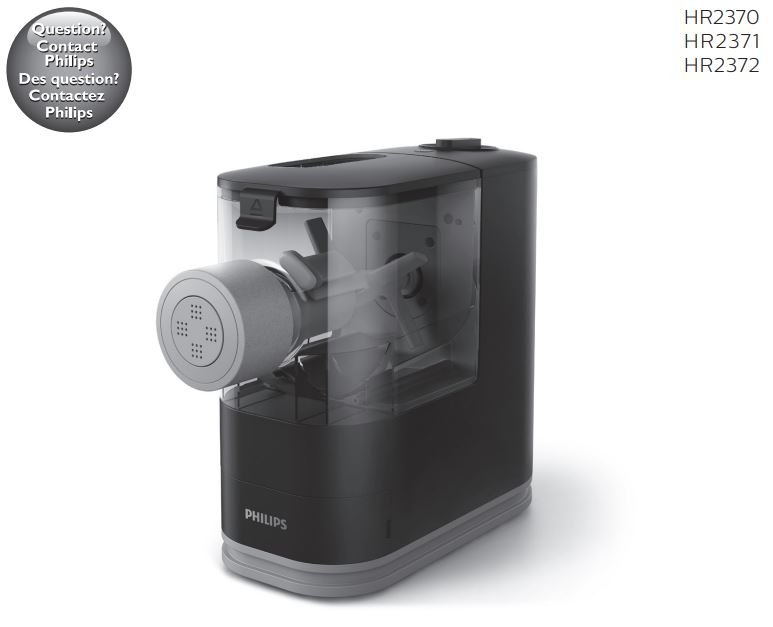
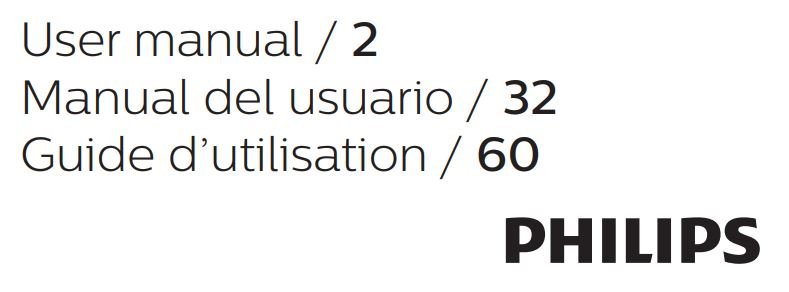
Quick Start Guide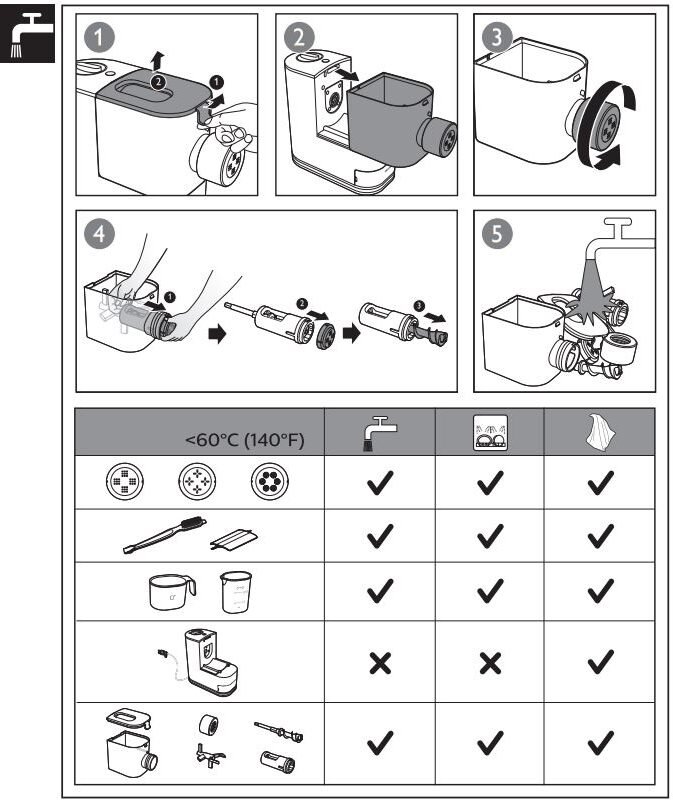
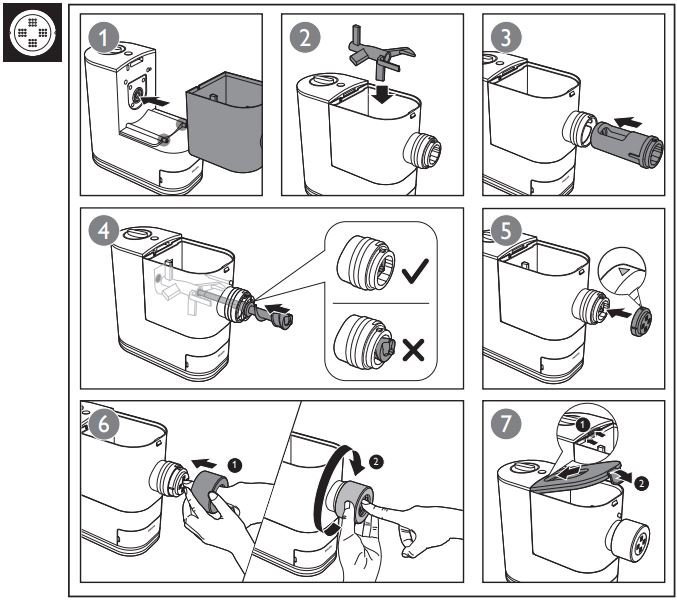
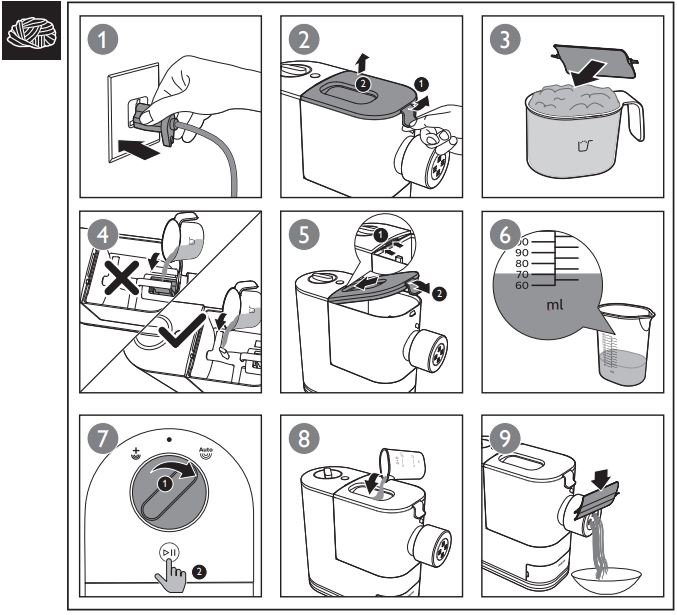
IMPORTANT SAFEGUARDS
When using electrical appliances, basic safety precautions should always be followed including the following:
Read this user manual carefully before you use the appliance and save it for future reference.
⚠️Warning
SAVE THESE INSTRUCTIONS |
Congratulations on your purchase, and welcome to Philips!
To fully benefit from the support that Philips offers, register your product at www.philips.com/welcome.
Read this user manual carefully before you install and use the appliance. Save it for future reference.
What’s in the box
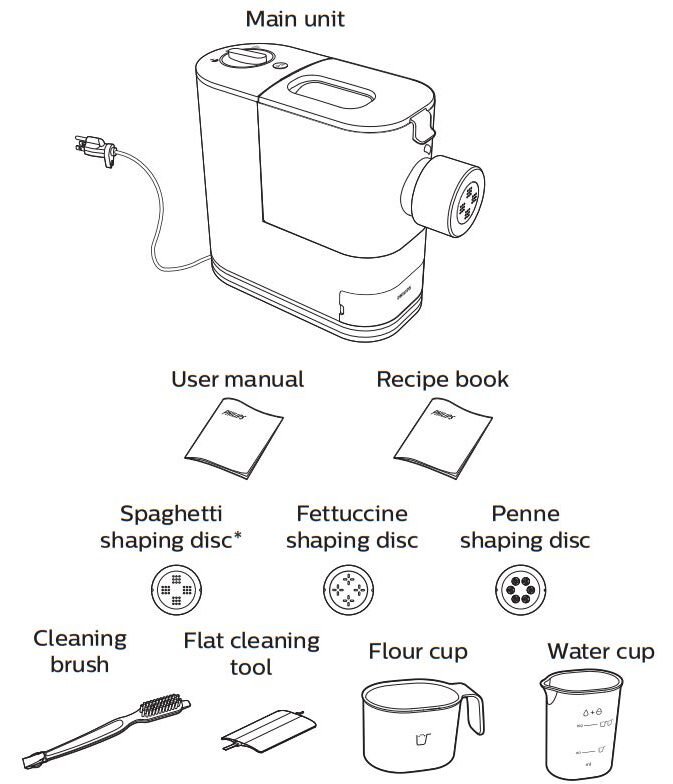
* The spaghetti shaping disc is assembled on the appliance upon purchase.
Overview
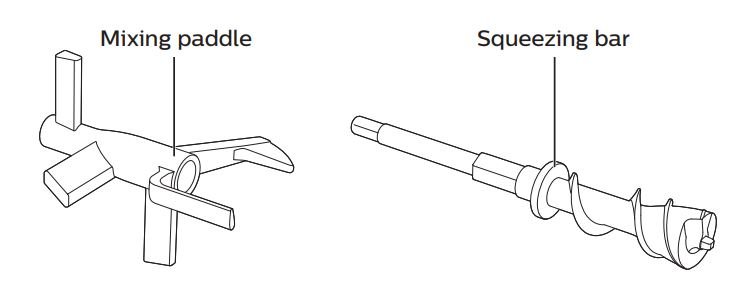
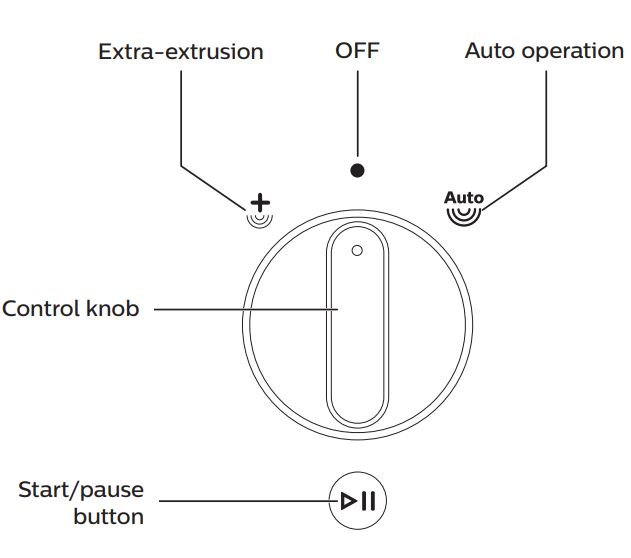
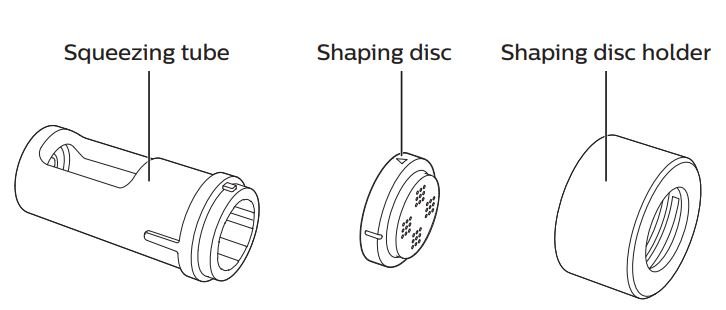
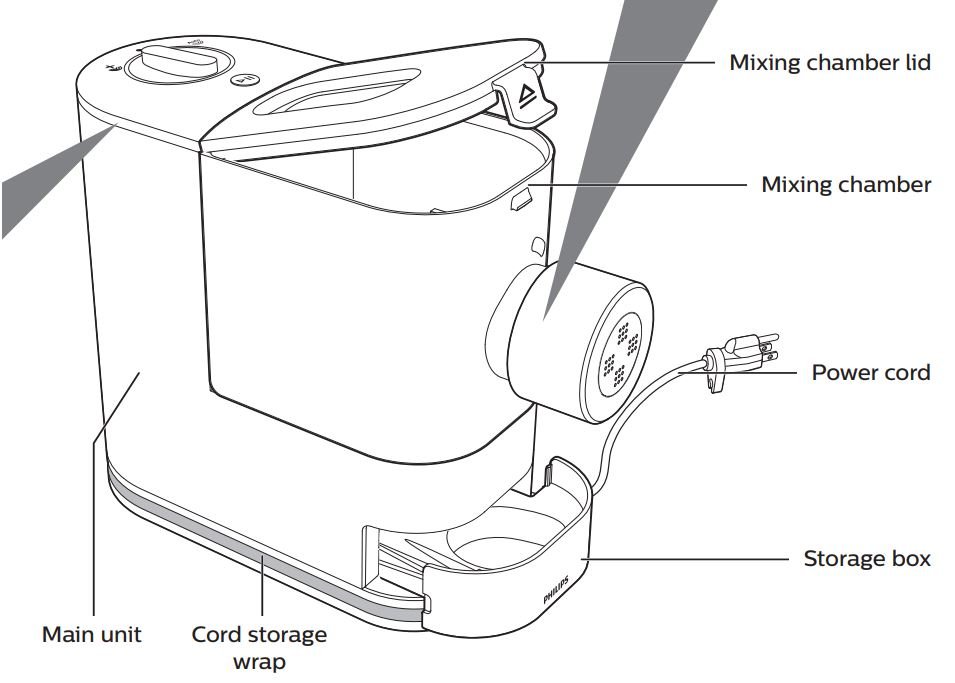
Disassembling and cleaning before first use
Important
|
- Pull (1) the lid to unlock it and then (2) remove the lid from the mixing chamber.

- Slide the mixing chamber off the main unit.

- Turn the shaping disc holder counterclockwise to remove it from the mixing chamber outlet.

- (1) Put your finger in the mixing chamber and push the squeezing tube outwards to slide it out of the mixing chamber outlet. (2) Detach the shaping disc, and then (3) pull the squeezing bar out of the squeezing tube.

- Take the mixing paddle out of the mixing chamber.

- Clean all detachable parts and accessories, and then wipe them dry.

Assembling
Follow below assembling steps to install the pasta maker.
Important
|
- Slide the mixing chamber onto the main unit.
Note:
• Make sure the fixing levers (1) on the main unit are fitted with the openings on the bottom of the mixing chamber.
- Put the mixing paddle in the mixing chamber as shown in the illustration.

- Insert the squeezing tube into the mixing chamber.
Note:
• Make sure the big opening on the squeezing tube faces up when you insert the tube into the chamber.
- Insert the squeezing bar into the mixing chamber. Make sure the squeezing bar slides all the way through both the squeezing tube and the mixing paddle and into the shaft (1) in the main unit.
Note:
• Slightly turn the mixing paddle to make sure the squeezing bar is connected correctly with the shaft in the main unit.
- Attach the shaping disc on the mixing chamber outlet.
Note:
• Make sure the flat side of the shaping disc is facing out.
• Make sure the shaping disc fits into the fixing point on the squeezing bar.
• Make sure the arrow on the shaping disc face upwards when you attach it on the mixing chamber outlet.
- (1) Press the shaping disc through the opening of the shaping disc holder, and then assemble the holder on the mixing chamber outlet. (2) Turn the holder clockwise to firmly lock it in place.
 Always attach the shaping disc on the mixing chamber outlet before you assemble the shaping disc holder. Never put the shaping disc in the shaping disc holder and assemble them on the mixing chamber outlet at the same time.
Always attach the shaping disc on the mixing chamber outlet before you assemble the shaping disc holder. Never put the shaping disc in the shaping disc holder and assemble them on the mixing chamber outlet at the same time.
- Attach the lid onto the mixing chamber.
Note:
• If the mixing chamber lid is not properly installed, the safety switch will prevent the appliance from working.
Using the pasta maker
Important
|
Preparing the ingredients
- Put the plug of the appliance into the power outlet. The pasta maker will sound once.
Note:
• Make sure all the parts are well assembled before plugging in.
- (1) Pull the lid to unlock it and then (2) remove the lid from the mixing chamber.

- Scoop one full cup of flour using the flour cup. Scrape off any excessive flour from the cup edge with the supplied flat cleaning tool. One full cup of flour weighs around 200 grams, and is equivalent to 1-2 servings..
 Note:
Note:
• Do not shake or hit the flour cup to remove excessive flour. This will affect the flour weight.
• Use a kitchen scale to measure the weight more accurately.
- Pour the flour into the chamber. If you want to make 2-3 servings, add a second cup of flour as you will need 2 cups (~400g) of flour in total.
 Note:
Note:
• Do not put less than 200g or more than 400g of flour in the chamber. If you put too little or too much flour in the chamber, the appliance will not operate.
• Do not pour the flour into the opening of the squeezing tube, otherwise the flour in the squeezing tube will not be mixed evenly.
- Attach the lid onto the mixing chamber.
Note:
• The appliance will not start working if the chamber lid is not properly closed. During the pasta making process, if the chamber lid becomes loose, the appliance will automatically stop working.
- Refer to the section “Water and flour ratio” and measure the required amount of water or egg mixture with the supplied water cup.
Note:
• Do not pour water into the mixing chamber before the pasta maker starts running.
• Make sure to measure the liquid volume at eye level on a flat surface.
There are 2 sets of water markings on the supplied water cup.
Side A with two liquid levels is only designed for normal pasta (all-purpose flour mixed with egg mixture), which is the most popular pasta.
- 200 g (1 supplied cup) all-purpose flour + 80 ml egg mixture (including 1 egg).
- 400 g (2 supplied cups) all-purpose flour + 160 ml egg mixture (including 2 eggs).

Side B with specific volumes is for other pasta.
- All-purpose flour mixed with pure water/ veggie juice mixture.
- Various other flours (as specified in the table below) with egg mixture/ pure water/ veggie juice mixture, etc.

Check the following table for detailed water and flour ratio.
Water and flour ratio
Note:
- This table provides the flour-liquid ratio base on 200 g of flour. When using 400 g of flour to make pasta, double the liquid volume (including egg) to get the right flour-liquid ratio.
| Flour | Liquid | Liquid volume | Side A/B |
| All-purpose flour 200g | Egg mixture(including 1 egg) | 80 ml | A |
| Pure water | 70 ml | B | |
| Spinach juice | 75 ml | B | |
| Spinach juice+egg mixture (including 1 egg) | 75 ml | B | |
| Beet juice | 75 ml | B | |
| Beet juice+egg mixture (including 1 egg) | 80 ml | B | |
| Carrot juice | 75 ml | B | |
| Carrot juice+egg mixture (including 1 egg) | 80 ml | B | |
| Squid ink egg mixture (including 1 tsp squid ink and 1 egg) | 80 ml | B | |
| Tomato puree+water (including 2 tbsp puree) | 75 ml | B | |
| Tomato puree+egg +water (including 1 tbsp puree and 1 egg) | 85 ml | B | |
| Durum (Semolina flour 150 g + allpurpose flour 50 g) | Egg mixture | 75 ml | B |
| Pure water | 65 ml | B | |
| Spinach juice | 70 ml | B | |
| Spinach juice+egg mixture (including 1 egg) | 75 ml | B | |
| Beet juice | 70 ml | B | |
| Beet juice+egg mixture (including 1 egg) | 75 ml | B | |
| Carrot juice | 70 ml | B | |
| Carrot juice+egg mixture (including 1 egg) | 75 ml | B | |
| Squid ink egg mixture (including 1tsp squid ink and 1 egg) | 75 ml | B | |
| Whole wheat 200 g | Egg mixture (including 1 egg) | 90ml | B |
| Pure water | 80ml | B | |
| Bread flour 200 g | Egg mixture (including 1 egg) | 80ml | B |
| Pure water | 65ml | B | |
| Spelt 200 g | Egg mixture (including 1 egg) | 90ml | B |
| Soba (buckwheat flour 130 g + allpurpose flour 70 g) | Egg mixture (including 1 egg) | 80ml | B |
Important
|
Note:
- To ensure the quality of the pasta, use gluten flour to make pasta; add the recommended liquid proportion.
- Seasonal changes and using ingredients from different regions may affect the flour/water ratio.
- When making egg pastas or vegetable pastas follow these steps:
• Measure the egg and liquid to the recommended level.
• Whisk the mixture evenly before pouring it into the chamber through the slot in the lid. - See the recipe book provided for more delicious pasta ideas.
- When making the egg mixture, crack the egg into the water cup. Add water up to the required amount, and then whisk the water and egg to combine.
- When making the vegetable mixture, crack the egg into the water cup. Add vegetable juice up to the required amount, and then whisk the juice and egg to combine.

- “Gluten” is a binder which makes pasta not break as easily. Gluten-free flour contains no such binder, so it needs a thickener to act as the “binder”, such as Xanthan gum, Guar, etc. Various kinds of gluten-free flour perform differently when making pasta. Some flours are not suitable to make pasta such as coconut flour and white rice flour; some work favorably, such as quinoa, buckwheat, etc.
Starting the pasta making program
Important
|
- Turn the control knob to (1) select the automatic pasta making process, and then (2) press the Start/Pause button.

- After the kneading starts, slowly pour in the liquid along the entire length of the slot in the lid.
Note:
• During dough mixing, do not add other ingredients after you have poured in the liquid. Otherwise, it will affect the results of the pasta texture.
- After the pasta maker finishes kneading, it will beep a few times and the pasta extrusion will start after a few seconds. Place a container right under the outlet. Cut the pasta into the desired length with the cleaning tool.
Note:
• If the ratio of liquid and flour is not correct, the extrusion will not succeed. In this case, prepare the ingredients again.
• Move the cleaning tool downwards to cut the pasta.
- When the extrusion process is complete, the appliance will beep a few times.
Note:
• Do not turn the control knob to the “OFF” position before the whole process is over (you will hear the “beep” sound).
• The whole working process (including kneading and extruding) takes around 18 minutes for 400g of flour. - After the pasta making is complete, if you notice some leftover dough inside the chamber, you can (1) turn the control knob to the OFF position first, and then (2) turn the control knob to the extra-extrusion position. (3) Press the Start/Pause button to start the extra-extrusion program.
Note:
• You may find some fine pasta threads on the pasta surface. This is normal.
• The cooking time of the pasta varies depending on personal preferences, pasta shapes, and number of servings.
Cleaning
Important
|
- Turn the control knob to “OFF” and disconnect
the plug from the power outlet.
- (1) Pull the lid to unlock it and then (2) remove the lid from the mixing chamber.

- Slide the mixing chamber off the main unit.

- Turn the shaping disc holder counterclockwise to remove it from the mixing chamber outlet.

- (1) Put your finger in the mixing chamber and push the squeezing tube outwards to slide it out of the mixing chamber outlet.(2) Detach the shaping disc, and then (3) pull the squeezing bar out of the squeezing tube.

- Take the mixing paddle out of the mixing chamber.

- Clean the shaping disc with the supplied cleaning tool to remove the dough residues. After that, you can clean it with water.

- Use the supplied cleaning brush to clean all detachable parts with dishwashing liquid and warm water or clean in the dishwasher. Wipe all parts dry.
Tip:
• Use the pointing end of the cleaning brush to clean the inner bottom of the squeezing tube.
- Use a dry cloth to clean the main unit, control knob, and the exterior of the pasta maker.
Note:
• After cleaning, make sure all parts and the shaping disc air dry thoroughly before storing. Assemble the pasta maker back for next use.
This appliance has no other user-serviceable parts. For assistance in the U.S. or Canada only call 1-866-309-8817.
Storage
- Set the power cord in the clip on the power plug and wind the power cord around the cord storage wrap.

- Dry the shaping discs and store them in the storage box.
The small groove in the storage box is designed for the cleaning tool of the angel hair shaping disc, which is not included in this pasta maker. They will be launched and sold separately.
- Store the pasta maker in a dry, well ventilated place after use.
Troubleshooting
This chapter summarizes the most common problems you could encounter with the appliance. If you are unable to solve the problem with the information below, visit www.philips.com/support or in the U.S. or Canada only, call 1-866-309-8817 for assistance.
The appliance does not sound after the plug is put in the wall outlet.
- The plug is not connected properly, or the outlet is not connected to power source.
Check whether the power plug is plugged correctly and the outlet is working properly.
The appliance does not start the pasta making process after the plug is put in the wall outlet.
- You have not chosen a pasta making program or pressed the start button ⏯️.
Choose a pasta making program and press the start button ⏯️.
After pressing the start button ⏯️, the appliance makes alarm sounds and does not work.
- The chamber lid is not assembled properly.
Make sure you follow the user manual to assemble the chamber lid properly.
The chamber lid is pushed open from the inside.
- There’s too much flour in the mixing chamber.
The maximum amount of flour for each batch is 400g. If you have put more than 400g of flour in the mixing chamber, reduce the amount and make another batch of pasta. - The ratio of flour and water provided in the “Flour/water ratio table” was not followed. The dough is too wet.
Disconnect from the power source, clean the pasta maker, and follow the user manual again to restart the pasta making. - The chamber lid is not assembled properly.
Make sure you follow the user manual to assemble the chamber lid properly
During the pasta making process, the appliance stops working, and there is no alarm sound.
- The pasta maker has overheated due to long and continuous working time.
Disconnect from the power source, and allow the pasta maker to cool down. To better protect the lifetime of the appliance, the continuous working time should be less than 40 minutes. You can use the appliance again after 30 minutes of rest.
During the pasta making process, the appliance stops working, and makes alarm sounds.
- The ratio of flour and water provided in the “Flour/water ratio table” was not followed. The dough may be too dry.
- The mixing paddle may be blocked by some foreign objects.
- The wrong program is selected.
Disconnect from the power source, clean the pasta maker, and follow the user manual again to restart the pasta making.
The mixing paddle is running idle, and there is no pasta coming out.
- The ratio of the flour and water is incorrect.
Disconnect the plug from the power source and discard dough. Clean the pasta maker, measure ingredients correctly (use a kitchen scale to measure the flour weight more accurately), and follow the user manual again to restart the pasta making - The flour becomes damp after longtime storage.
Use flour that is fresh or properly stored.
The pasta breaks easily.
- The ratio of the flour and water is incorrect.
Disconnect the plug from the power source and discard dough. Clean the pasta maker, measure ingredients correctly (use a kitchen scale to measure the flour weight more accurately), and follow the user manual again to restart the pasta making. - You did not use the correct type of flour.
Use all-purpose flour or flour with higher protein content (refer to the chapter ‘Using the pasta maker’ in the user manual or the supplied recipe book).
The pasta sticks together.
- The ratio of the flour and water is incorrect, too much water is poured in the mixing chamber.
Measure flour and water with the provided flour and water cup and according to the “flour/ water ratio table”. Use a kitchen scale to measure the flour weight more accurately.
Too much leftover dough inside the chamber.
- The flour is either exposed to moisture before use, or the dough is too wet.
Keep your flour dry during storage. Follow the user manual instructions to restart the pasta
making. - The chamber, the mixing paddle, the shaping disc are not cleaned properly before use.
Make sure all parts are clean before use. - The mixing paddle or the chamber is still wet.
Make sure all parts are completely dry before use. - Water is not added in the right order.
The flour type is not suitable.
Follow the user manual instructions to make pasta.
Small amount of water is leaking out from the appliance.
- Water is added before the program starts.
Follow the user manual instructions to add water right after the program starts.
After pasta making, the squeezing tube cannot be pushed out of the mixing chamber.
- The appliance is stopped during extrusion before the pasta making process is finished completely.
- Restore the disassembled parts back in place until the appliance is assembled properly, and turn the control knob to the OFF position.
- Plug in, select the automatic pasta making program, and press the start button. Keep the mixing paddle rotating for around 10 seconds, and then turn the control knob to the OFF position.
- Unplug the appliance, disassemble and clean the appliance as described in the user manual (see chapter “cleaning”).
Product information
| Model | HR2370, HR2371, HR2372 |
| Motor power | 150W |
| Rated voltage | AC120V (60Hz) |
| Dimensions (L x W x H) | 350 mm x 135 mm x 287 mm / 13.8 in x 5.3 in x 11.3 in |
| Net weight | 4.7 kg / 10.4 lb |
• For rated voltage and frequency information, refer to the type plate on the product. Product information is subject to change without prior notice.
Disposal
Your product is designed and manufactured with high quality materials and components, which can be recycled and reused. For recycling information, please contact your local waste management facilities or visit www.recycle.philips.com.
 This symbol on the product’s nameplate means it is listed by Underwriters Laboratories, Inc.
This symbol on the product’s nameplate means it is listed by Underwriters Laboratories, Inc.
Warranty
One Year Limited Warranty
Philips warrants that this product shall be free from defects in material, workmanship and assembly, under normal use, in accordance with the specifications and warnings, for a period of one year from the date of purchase. This warranty extends only to the original purchaser of the product, and is not transferable. To exercise your rights under this warranty, you must provide proof of purchase in the form of an original sales receipt that shows the product name and the date of purchase. For customer support or to obtain warranty service, please visit our website www.philips.com/support. THERE ARE NO OTHER EXPRESS OR IMPLIED WARRANTIES. Philips’ liability is limited to repair or, at its sole option, replacement of the product. Incidental, special and consequential damages are disclaimed where permitted by law. This warranty gives you specific legal rights. You may also have other rights that vary from state to state, province to province or country to country.
In U.S. only
Manufactured for:
Philips Consumer Lifestyle
A Division of Philips Electronics North America Corporation
P.O. Box 10313, Stamford, CT 06904
Canada only
Manufactured for:
Philips Electronics Ltd.
281 Hillmount Road
Markham, ON L6C 2S3
Manufactured for:
– Colombia: 01-800-700-7445
– Costa Rica: 0800-507-7445
– República Dominicana: 1-800-751-2673
– Ecuador: 1-800-10-1045
– El Salvador: 800-6024
– Guatemala: 1-800-299-0007
– Honduras: 8002-791-9273
– México: 01800504 6200
– Nicaragua: 1-800-507-0018
– Panamá: 800-8300
PHILIPS and Philips Shield are Registered Trademarks of Koninklijke Philips N.V.
© 2016 Philips Electronics North America Corporation. All Rights Reserved.

Specifications are subject to change without notice
Les spécifications peuvent changer sans pré-avis
© 2016 Koninklijke Philips N.V.
All rights reserved.
Tout droits réservés.
4241 210 23322
Download Manual PDF
Philips HR2370 Compact Pasta and Noodle
Maker User Manual PDF Download
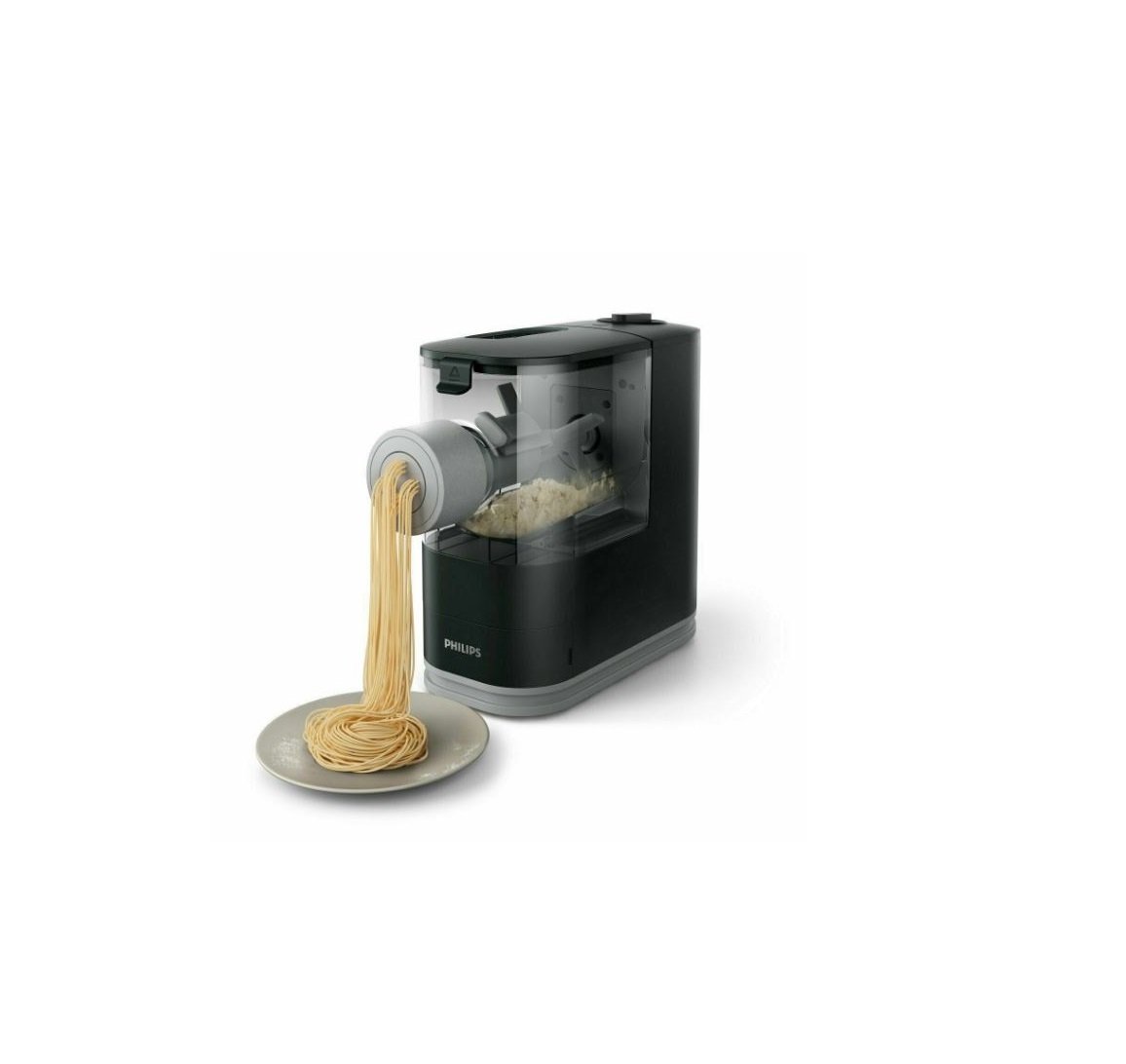
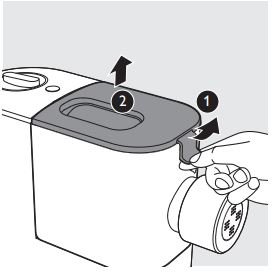
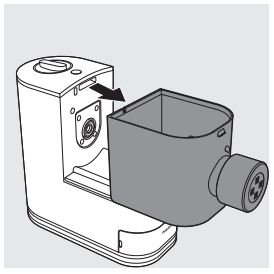
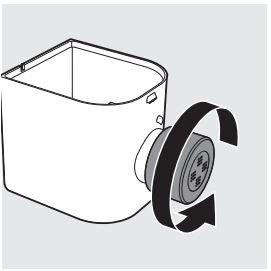
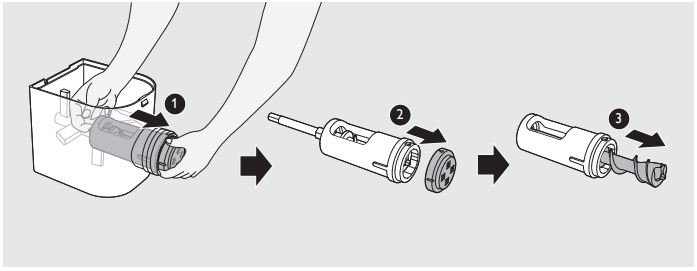
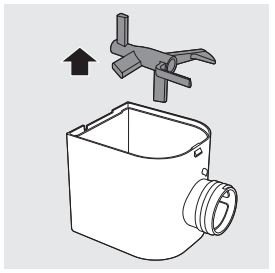
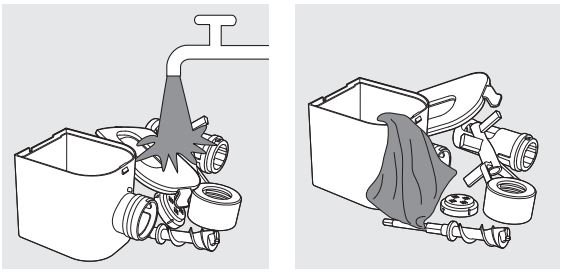
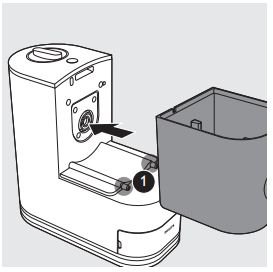
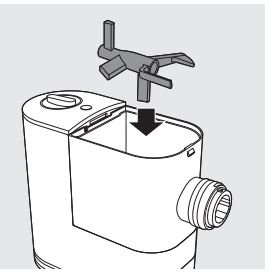
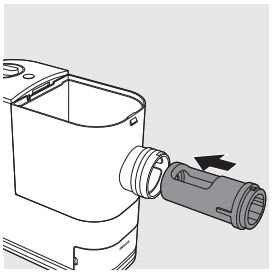
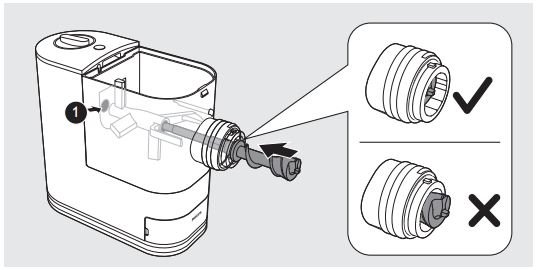
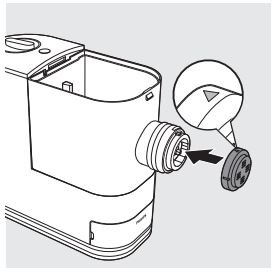
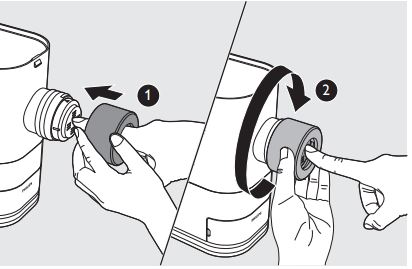
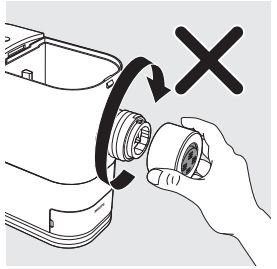
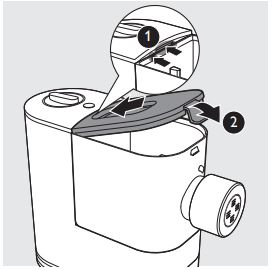
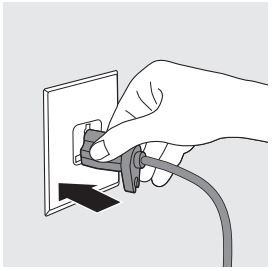
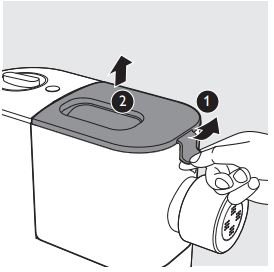
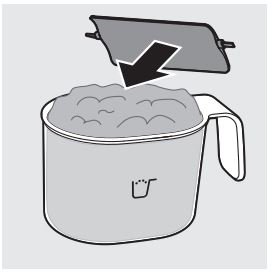 Note:
Note: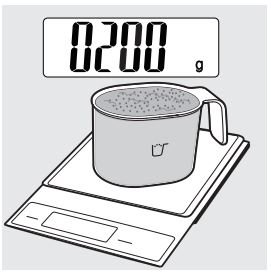
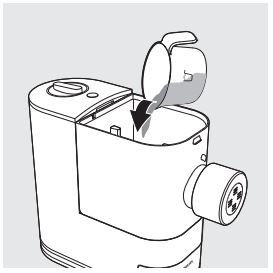 Note:
Note: